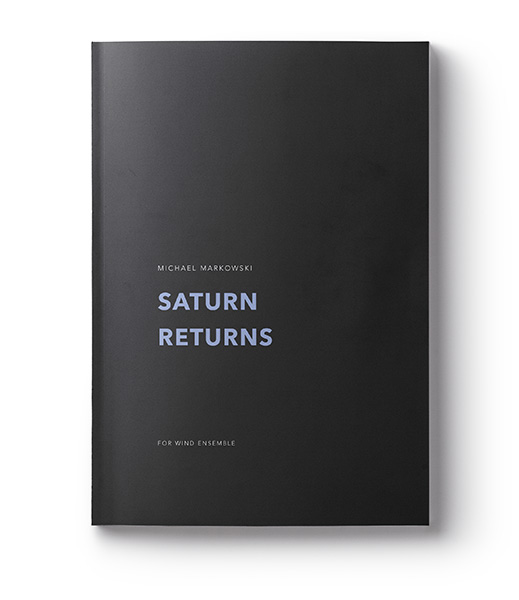Saturn Returns
Program Note
The planet Saturn takes approximately 29 years to orbit the Sun. When we grow up and enter our mid-to-late twenties, Saturn “returns” to the same position in the sky as it was when we were born. This is often a time of great reflection, filled with intense self-questioning about our careers, our relationships, and our very sanity. The significance here is that the completion of Saturn’s first orbit often symbolizes maturity as a person enters the next phase of his or her life—a “coming-of-age” from childhood to adulthood.
My friend, Jonathan Musgrave, and I were chatting over dinner and drinks one night last November. I had played him some early mockups of this then-untitled piece and talked him through my initial concepts for the music a few days before, but the piece wasn’t really taking any particular shape yet. I was given a deadline extension from the commissioning school, but the guilt and professional anxiety of not being able to create when you most need to was starting to set in. As I remember, I was confiding in Jon about all of these growing anxieties—the work-in-progress, life as a composer, my own personal and romantic relationships—when he interrupted me, “How old are you?” “27.” “Ah, yes. This sounds exactly like your Saturn Return.” Typical me, I leaned in closer and cupped my ear towards him, “my what?”
To understand exactly how Renaissance Jon is, you have to understand that in addition to being an accomplished musician and conductor (and an all-around smarty-pants), he is also a professional massage therapist, which makes him the absolute perfect person to explain this piece in both musical and metaphysical terms. But first, I was in for a history lesson.
“Saturn is an interesting figure in the Greco-Roman pantheon. He’s like the old curmudgeonly uncle who always tells the truth, but is rarely nice about it.” “Oh. So, like, if he were here right now, he would probably tell us how boring this all is, right?” “Sure.” He was unphased by my jab and continued the lecture.
“Saturn is closely associated with structure, form, and time: the stable, reliable parts of existence. He is also associated with simplicity, definition, realism, and truth. And like all of the gods and goddesses, Saturn was personified in the heavenly bodies. Until the late eighteenth century, it was thought to be the final planet of our solar system, the last one visible from Earth with the naked eye. Hence, Saturn was associated with endings, especially the yearly crisis of winter, and death.”
Endings? Talk of “endings” when I had barely even written a beginning was making me even more anxious about finishing my work on time, and buzzwords like “crisis” and “death” were also not exactly encouraging.
“Saturn takes 29 and a half years to orbit the Sun, and so, approximately 30 years after we are born, Saturn returns to the same place in the cosmos that it occupied at our births. As we approach our late 20s, the values of Saturn become more present in our lives. His return slows down time and causes us to rethink and reevaluate our basic beliefs, careers, and close relationships. It is a time of pairing down, discarding what is not working in our favor, and strengthening what is. Saturn reminds us that endings and change are a necessary part of growth.”
By the end of the night, I could actually feel myself relating to this concept, if only on an emotional level. I had turned 27 only days before and with so many aspects of life coming into question, I continued writing the piece. The conversation between Jon and I seemed to help tremendously and I slowly began to bring the piece out of the clouds and into a bit more clarity.
Commissioned By
The Susan E. Wagner High School Symphonic Band
Paul Corn
Premiere
Saturn Returns premiered on May 14, 2014 at Susan E. Wagner High School (Staten Island, New York) performed by the Symphonic Band conducted by Paul Corn.
View program here.
Publisher
Markowski Creative (ASCAP)
Instrumentation
Piccolo
Flute 1 & 2
Oboe
Bassoon
B-flat Clarinet 1-4
B-flat Bass Clarinet
B-flat Contrabass Clarinet
Soprano Saxophone
Alto Saxophone 1 & 2
Tenor Saxophone
Baritone Saxophone
B-flat Trumpet 1-4
Horn 1-4
Trombone 1-4
Euphonium 1 & 2
Tuba
String Bass
Percussion 1: Timpani, Shaker, Brake Drum
Percussion 2: Crotales, Glockenspiel
Percussion 3: Vibraphone, Suspended Cymbal
Percussion 4: Marimba
Percussion 5: Chimes, Crash Cymbal
Percussion 6: Five Concert Toms, Snare Drum, Wood Block, Tambourine, Trash Cymbal, Splash Cymbal
Percussion 7: Large Marching Bass Drum, Tam-Tam (shared), Crash Cymbal
Percussion 8: Concert Bass Drum, Tam-Tam (shared)
Errata
The most accurate version of the score and parts is dated July 27, 2014. Please correct the following errata:
Contrabass Clarinet: mm. 232-235, please raise this passage up an octave (unless you have a fancy instrument with a low ‘C’ extension!)
Year Completed
2014

